The Five Elements of Ayurveda and Traditional Chinese Medicine
Jan 26, 2023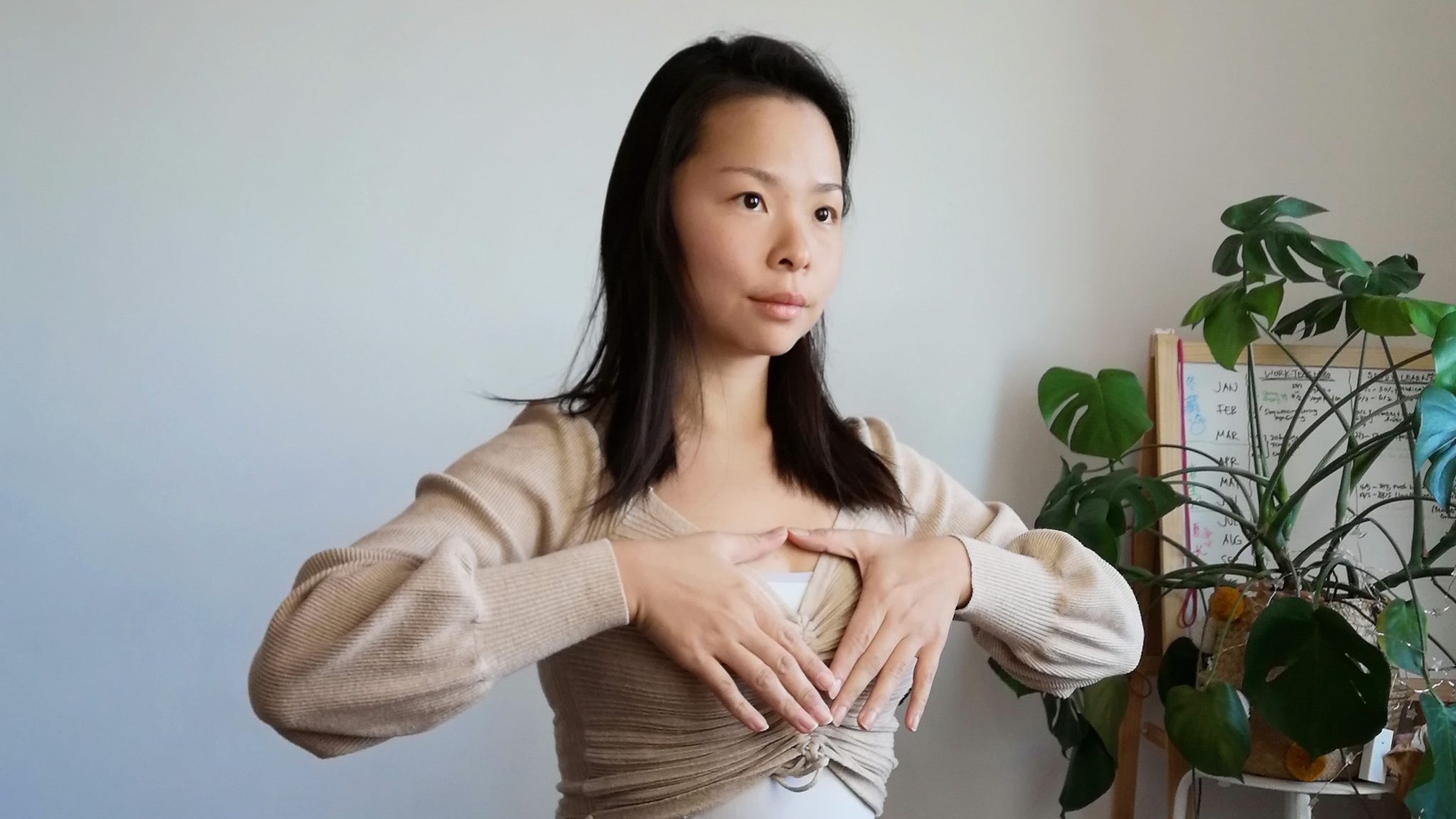
Restoring Harmony by Reclaiming Our Cyclical Nature
You’ve probably heard of the Five Elements from Yoga and Ayurveda, but did you know they exist in Traditional Chinese Medicine (TCM) and Qigong as well? As an educator who teaches both Qigong and Yoga and trains Yoga teachers on how to intelligently integrate Qigong in their classes, I am often asked, ‘How do the Five Elements in Ayurveda compare to that in TCM?’ and ‘Which one is better?’. Before I answer these questions, let me tell you a story.
Two encounters with cyclical wisdom and seasonality
In January 2021, I met Manuel, a digital entrepreneur and startup investor who practises seasonality - he synchronises all the cycles of his multiple start-ups, initiating, planning, executing and closing, to maximise results and minimise efforts. Manuel also disappears into hibernation during the period of winter, re-emerging only during springtime.
Roughly around the same time, through a movement summit I came across the work of Sebastien Foucan, one of the world’s top Parkour athletes, who practises seasonality- adjusting his training and life according to the seasons. Sebastien gradually intensifies his training from Spring to a peak in Summer, then tapers it off in Autumn until coming to rest during Winter, and advocates all athletes he coaches to do the same for peak performance while maintaining longevity.
After these encounters, I started to see the seasons in all things, not just around me but also within me, and started to take interest in my menstrual cycle, intuitively feeling a deep connection between the four seasons of my cycle and the four seasons of nature, and the Five Elements in Ayurveda and Traditional Chinese Medicine (TCM). My hope is that, by inviting you on this journey, you might, too, experience the wonders of the Five Elements and reclaim your cyclical nature.
Exploring the uncharted lands of subtle body with curiosity and an open mind
Before starting our journey, let’s first acknowledge that the Five Elements within TCM and Ayurveda, and other concepts like the chakras, meridians and energy centres come from maps of the subtle body, the energetic realm. Maps are often subjective representations, portrayals of a landscape, world or space. Even more importantly, maps serve the function of guiding a specific user to navigate a space world for a specific purpose. Rather than scientists focused on correctness and accuracy, let’s instead put on the hat of an explorer- curious and open-minded, as we journey into the uncharted lands of the subtle body.
Comparing the Five Elements of Ayurveda and TCM
Let’s start by examining the Five Elements of Ayurveda and TCM. At first glance, Ayurveda’s Panchamahabhuta and Traditional Chinese Medicine’s Five Moving Forces WuXing 五行 share some commonalities, with three Elements, Earth, Water and Fire being in common. Second, you might notice that within Ayurveda there is Air and Ether but TCM has Wood and Metal.

Based on the image above, one might assume that Earth, Water and Fire are similar across both Ayurveda and TCM, and instead focus on comparing the two Elements that are different. You might even wonder why the Earth Element of Ayurveda is not aligned on top of the Earth Element of TCM, and the same for Fire and Water. This is because the Water Element in Ayurveda is not the same as the Water Element in TCM, and the same goes for Earth element and Fire element. (Some texts translate Akasa as ‘Space’ instead of ‘Ether’.)
Water in Ayurveda isn’t Water in TCM (Same goes for Fire and Earth)
Let’s take the example of Water. Water’s energy is downward movement in TCM (since water flows down) and the Kidney and Urinary bladder organs and meridian systems and adrenals. Instead in Ayurveda Water is associated with the Svadhisthana, Sacral chakra in the pelvis, and Prana vayu, an inward and upward moving breath rather than Apana vayu which is downward, which in Ayurveda is associated with the Earth element instead.
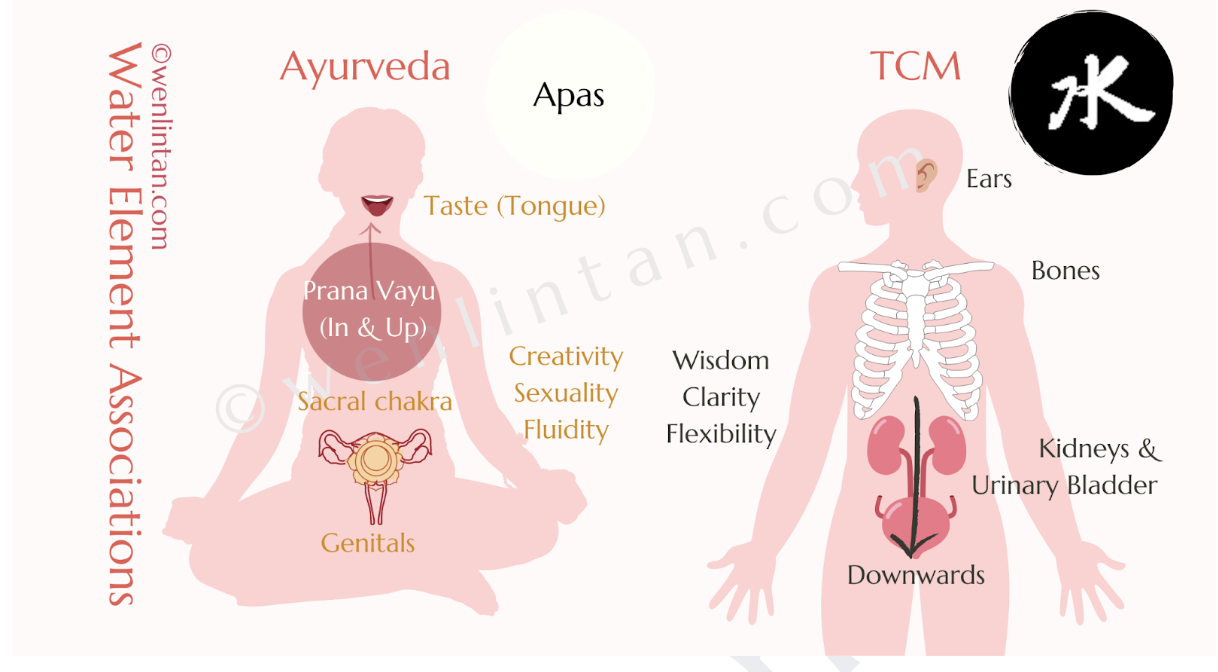
Furthermore Ayurveda’s Water is synonymous with emotions, passion, pleasure, creativity, fluidity, and sexuality while TCM’s Water is associated with wisdom, flexibility and clarity. In Ayurveda, Water’s colour is white, and associated organs are the tongue (for taste) and genitals (for reproduction), but within TCM its associated colours are black and organs are ears and bones.
Different maps can’t be compared like for like
The Five Elements in Ayurveda map vertically in accordance with the first five of the Seven Chakras and seven plexuses, i.e. the order from top down, with the first being Ether, followed by Air, Fire, Water, and lastly, Earth. Conversely the order of the Five Elements WuXing 五行 in TCM, better translated as the Five Phases or Five Moving Forces, in TCM as mapped onto the human body is in relation to the meridians and Five Zang organs, the Liver, Heart, Spleen, Lungs and Kidney, with the cyclic order being Wood, Fire, Earth, Metal and Water, followed the next cycle starting with Wood again, rather than any of the three energy centres or elixir fields: (This order, known as the 生 Sheng Generation cycle, is a cyclic pattern, with Wood following Water and the pattern continuing endlessly. Kavoussi, Ben. (2007). Chinese Medicine: A Cognitive and Epistemological Review. Evidence-based complementary and alternative medicine )
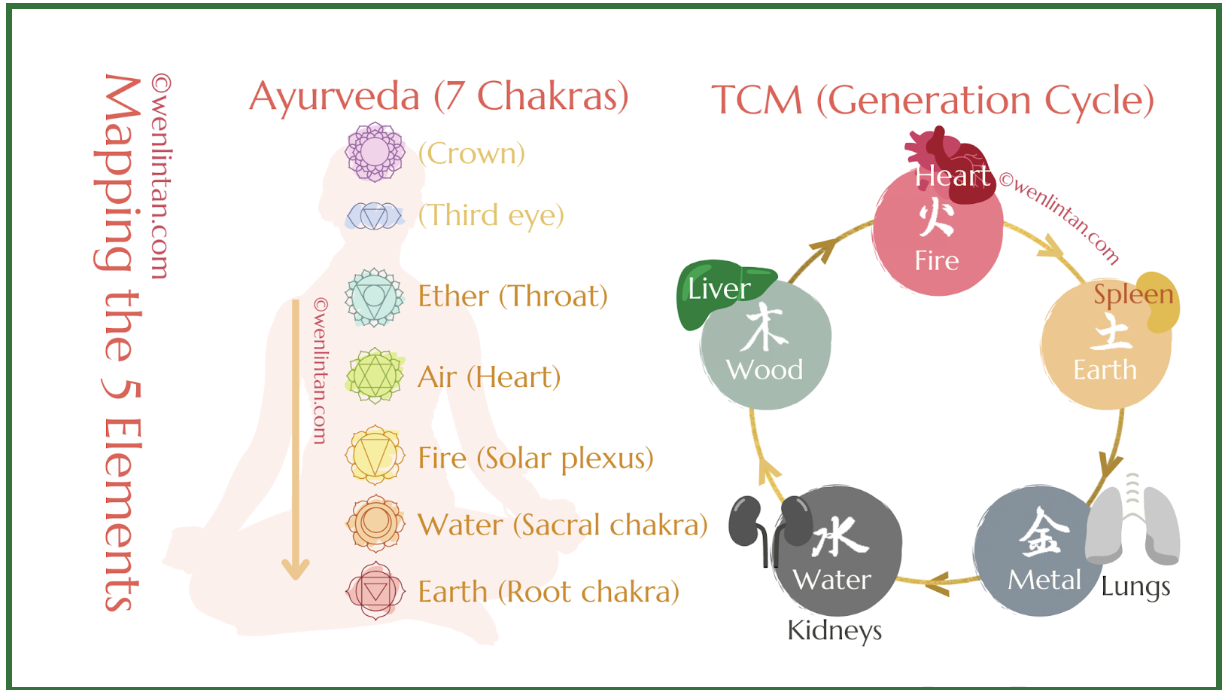
Juxtaposing like for like across the five Elements in Ayurveda and TCM and separately, trying to see how Air and Ether in Ayurveda relate to Wood and Metal and TCM is pointless as these two frameworks don't map directly onto each other.
(There is ongoing research linking the chakras with the 5 Elements from Chinese Medicine, though these connections have yet to be established and agreed on globally. Refer to this study: Chase CR. The Geometry of Emotions: Using Chakra Acupuncture and 5-Phase Theory to Describe Personality Archetypes for Clinical Use. Med Acupunct. 2018 Aug 1;30(4):167-178. doi: 10.1089/acu.2018.1288. PMID: 30147818; PMCID: PMC6106753.)
For the remainder of our journey together, rather than mapping the Five Elements in a molecular way, let’s uncover the true value underlying the Five Elements of Ayurveda and TCM respectively: their shared focus on our connection with nature and her cycles, as microcosms that flow with the cycles of the macrocosm.
United in their view that everything is interconnected (by virtue of the Five Elements)
Both systems state that the Five Elements manifest not just as inanimate things, forms in nature but are also energies, forces, phases and cycles that underpin each individual’s life stages, though each have some unique connections- Ayurveda’s Five Elements with Koshas, Chakras, Vayus and TCM with Emotions, Virtues, Numbers, Organs. The key here is not to get lost in the respective connections, but realise what both traditions point to is the fact that everything is rooted in the Five Elements, and thus interconnected. You can find an extensive list of the Five Elements Relationships in TCM here.
Relationships of the Five Elements

United in their view that Health as Harmony with Nature
Both systems believe that disease results from physical, emotional or spiritual imbalances from being out of tune with our cyclical nature. Thus, both approaches agree on the importance of aligning with biological rhythms, or “harmony between human and nature”, particularly circadian and seasonal rhythms. Aligning one’s lifestyle and activities according to the daily and seasonal cycles of nature is recommended to restore holistic health.
(Tianxing Zhang, Long Yan, Shilei Ma, Juan He, Human biological rhythm in traditional Chinese medicine, Journal of Traditional Chinese Medical Sciences, Volume 3, Issue 4, 2016, Pages 206-211,ISSN 2095-7548)
Cycles within us and around us
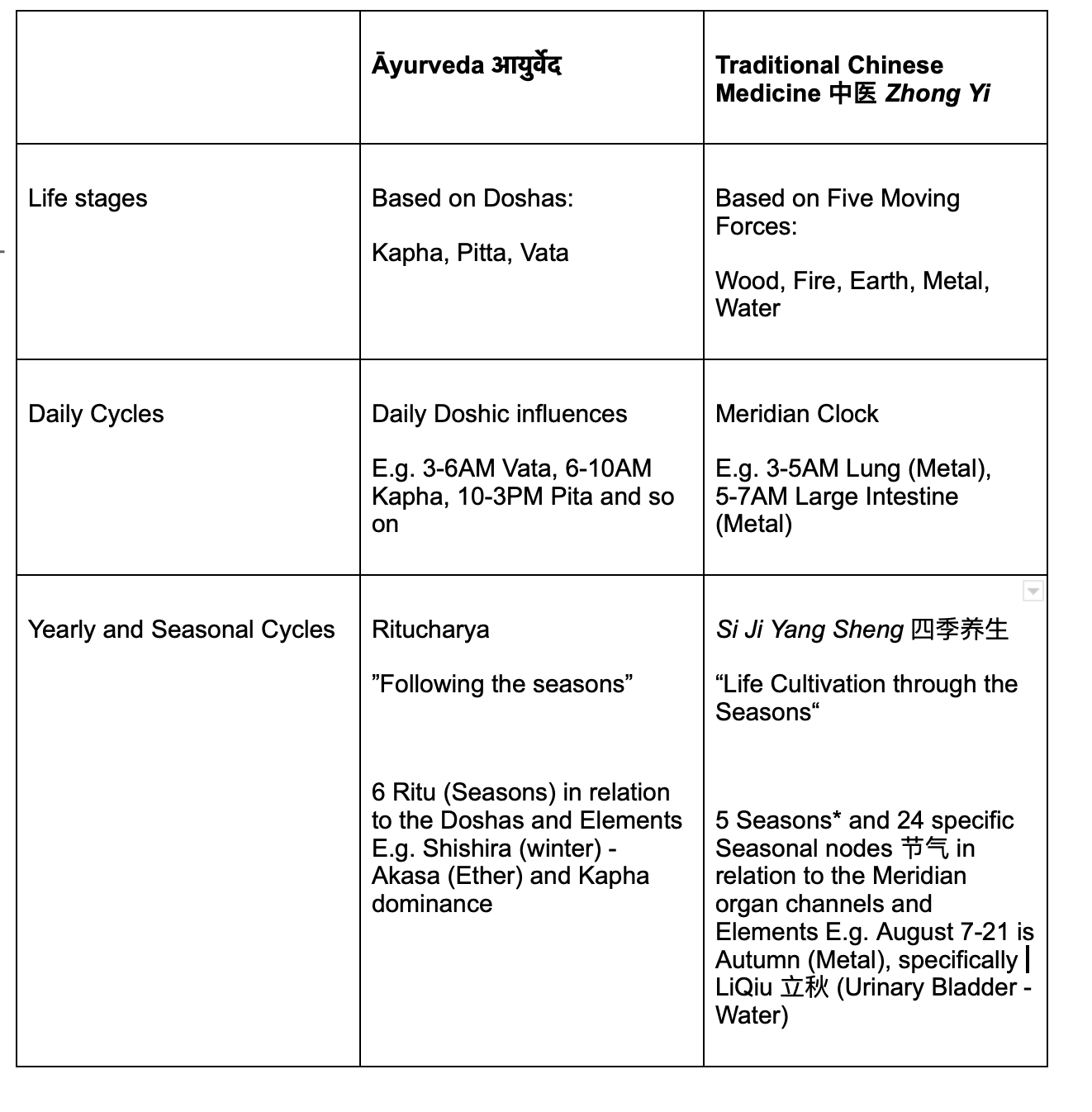
*Some Chinese Medicine Texts acknowledge a fifth season, ‘Late summer’ or ‘Harvest season’ associated with the Earth element.
United in their view that Internal and External factors are important
Both advocate a holistic approach to health and well-being that addresses both internal factors (physical, emotional, spiritual well-being) and external factors (restoring harmony with nature and external influences). A comprehensive approach encompassing diet, self-cultivation practices, geomancy, bodywork.
Restoring harmony by flowing with nature’s cycles
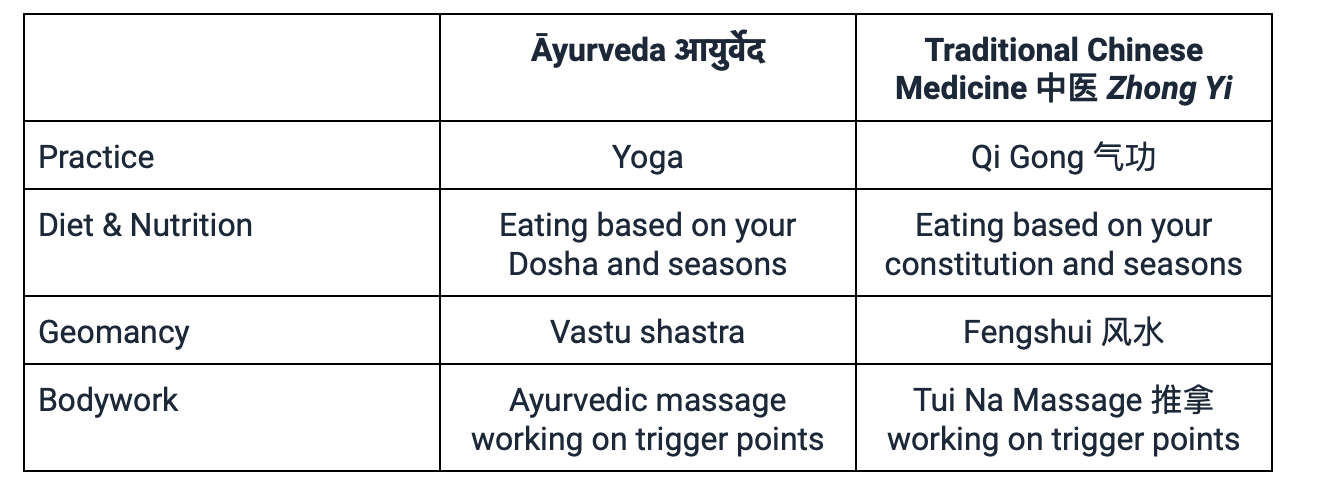
Understanding the importance of ‘When’
Through both systems, we are reminded it is not simply what we do and how we do it that matters, but importantly when we do it. The implication is that it is crucial for us to adapt our activities, including our personal practice and teaching according to the shifting energies of the seasons which reflect the elements.
Yoga that evolves to meet your shifting seasons and needs
For optimum health and longevity, just as foods eaten during Winter are different from that in Summer, a Yoga class would differ based on the season and time of day to meet practitioner needs. Furthermore, the external seasons outside in the world relate to the internal seasons we have inside of us. Therefore, Menstruation is energetically similar to Winter, as is Ovulation with the season of Summer. Thus, one’s self-practice during menstruation should be different from that when you are ovulating. Find out how to adapt your Yoga practice and classes for the four phases of your menstrual cycle here.
Going back to the questions, ‘How do the Five Elements in Ayurveda compare to that in TCM?’ and ‘Which one is better?’ Each has unique areas for us to explore- Ayurveda’s Five Elements, for example, connects us with the Koshas, the deeper layers of our being. Conversely, TCM’s Five Elements connects us with our emotions and helps us understand how to better manage them. Neither is better than the other; they are two distinct maps for us to navigate the subtle body to cultivate health and wholeness. Ultimately, both remind us that we are deeply connected with all aspects of the external and internal landscape that we live in, and that health can come to us through harmonising our activities and life with Nature.
Want to journey deeper? Tune in to Micaela of MyVinyasaPractice and Wenlin for a podcast chat in September to dive deeper into the Five Elements.
(Podcast Links: Spotify; Apple; Amazon)
BIO:
Wenlin is a Women’s Menstrual Health and Emotional Well-being Coach and Qigong and Yoga specialist. She helps menstruating women feel confident and at home in their body and optimize their creativity and productivity by harnessing the power of their menstrual cycle and natural bodily rhythms. 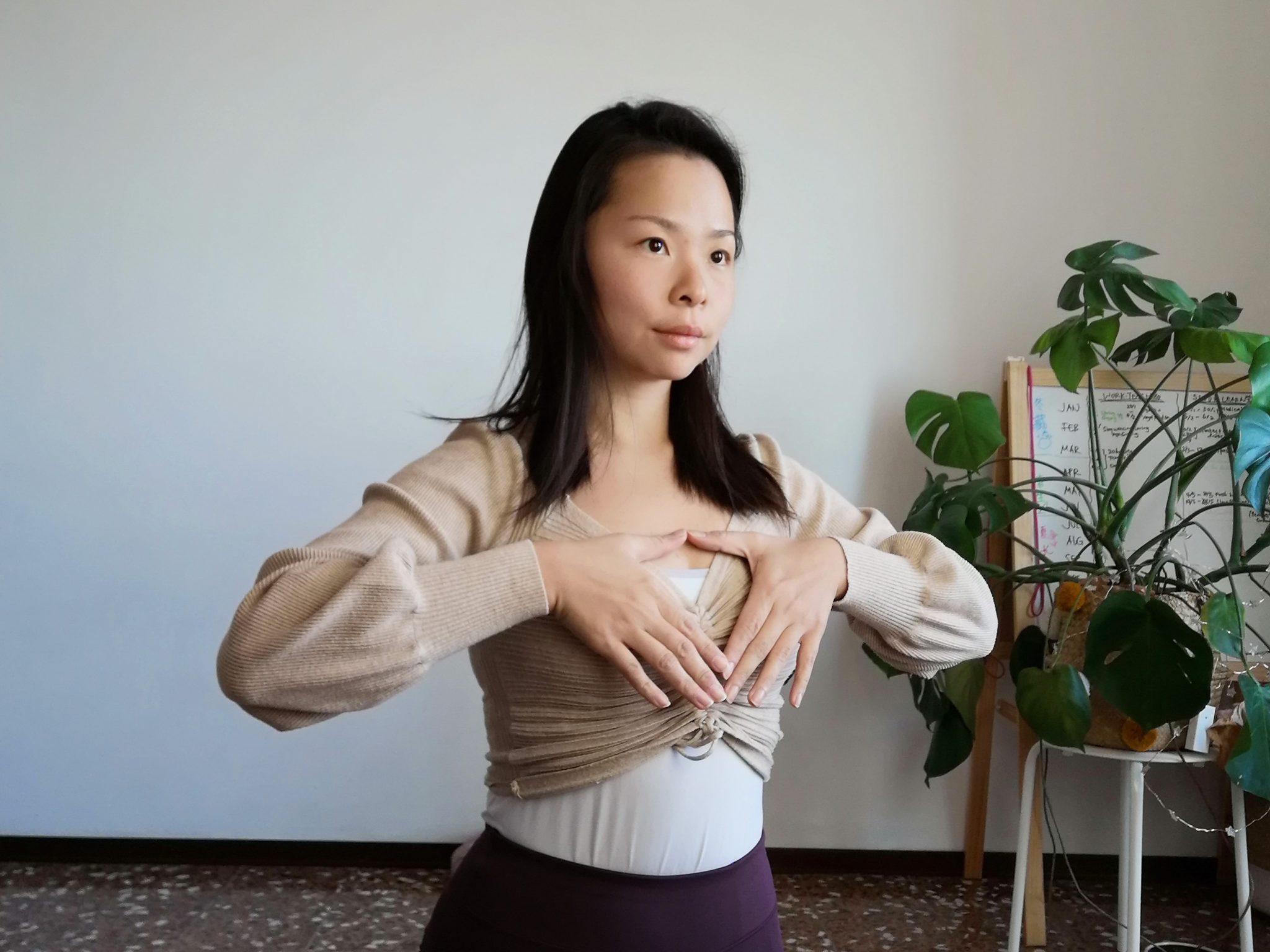
Website: https://wenlintan.com/
Instagram: https://www.instagram.com/flowwithwenlin/


